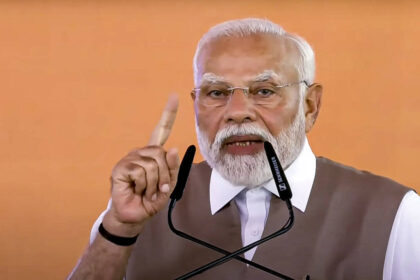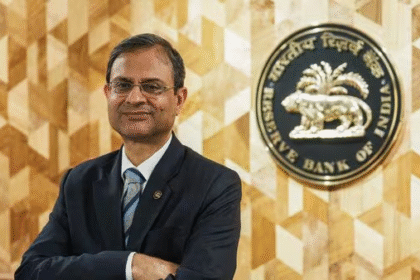BJP Invokes Ahilyabai Holkar as Gadariya Community Demands Political Representation
“When I see her statue on the banks of the Ganga, at the Kashi Vishwanath Dham, I feel a deep sense of pride – as a woman and as someone from her community,” says Vandana Tomar, showing us a photograph of her in front of the 18-foot black stone statue of Ahilyabai Holkar, installed at the entrance of the Kashi Corridor.
“To see someone from our background remembered like this, in such a sacred space, is beyond words,” says Vandana, who teaches at Subharti University in Meerut.
The statue was unveiled in December 2021, when the Kashi Vishwanath Dham was inaugurated. Among the other figures commemorated within the complex are Adi Shankaracharya and Bharat Mata, but for Vandana, it is Ahilyabai’s presence that holds the greatest significance.
“I write Tomar as a title but I’m a Gadariya like our queen,” continues Vandana. Ahilyabai Holkar, the 18th-century queen of the Holkar dynasty, is widely remembered for her piety and for the many temples she commissioned or restored. But for Vandana and others from her community, the recognition means something more – it marks the acknowledgment of the Gadariya identity, a sub-caste including communities of the Dhangars and Pals, traditionally involved in shepherding and livestock rearing.
The Gadariyas see themselves as vansaj – descendants – of Ahilyabai. According to oral traditions, Malhar Rao Holkar spotted the young Ahilyabai deeply immersed in temple rituals, and chose her as the bride for his son, Khanderao Holkar. Following the deaths of her husband and son, Ahilyabai ruled with skill and resolve. She is known for the reconstruction of key temples such as Kashi Vishwanath in Varanasi, Somnath in Gujarat and shrines across Rameswaram, Dwarka and Puri.
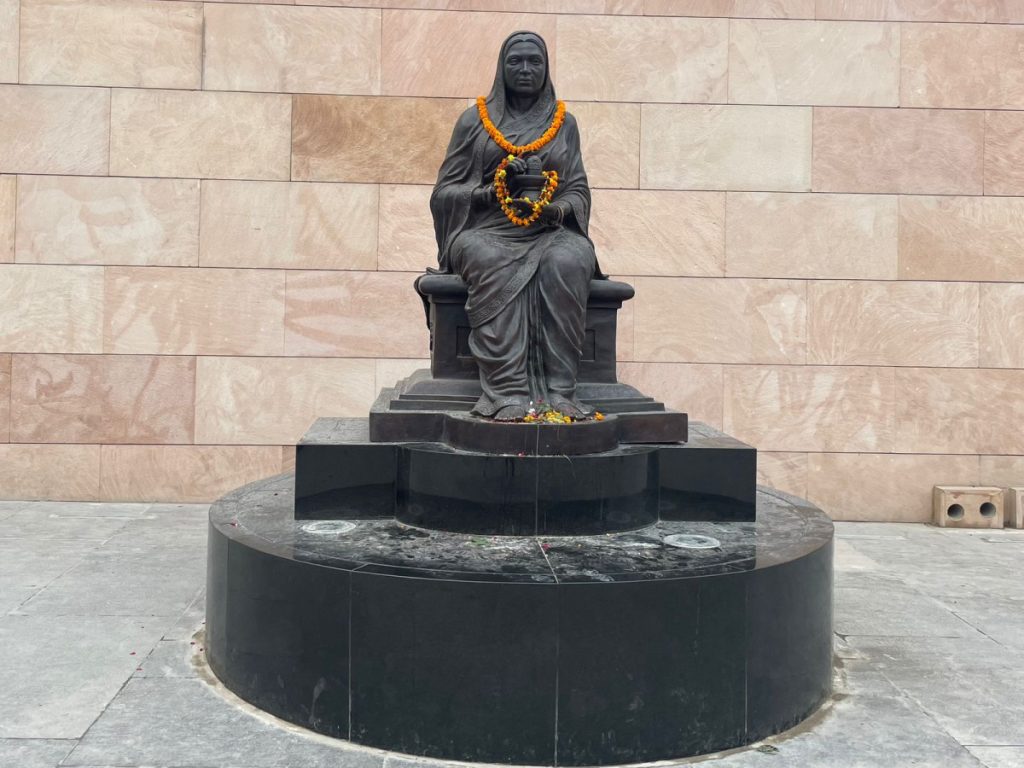
The stone statue of Ahilyabai at the Kashi Vishwanath Dham. Photo provided by author.
The perfect icon
For the Rashtriya Swayamsevak Sangh (RSS) and the BJP, Ahilyabai serves as a powerful and strategic icon – a deeply religious queen whose legacy seamlessly fits Hindutva narratives on multiple fronts.
Her temple-building legacy directly aligns with the RSS’s core project of reclaiming Hindu sacred spaces, particularly her restoration of Somnath and Kashi Vishwanath, two of the most important shrines in RSS temple politics.
As a ruler, she embodies the golden age of Hindu sovereignty that the RSS draws inspiration from for modern India – the legacy of Maratha and Peshwa-Brahmin rule that they see as a template for a Hindu rashtra.
Her identity as a woman from a Gadariya community fits the BJP’s electoral push among the more backward of the OBC communities – the Pals, Dhangars and Baghels who form crucial vote banks across northern and western India.
In recent years, efforts to position her as a national figure have gathered momentum, particularly ahead of her 300th birth anniversary on May 31, 2025. Today, Prime Minister Narendra Modi is the chief guest at a function in Bhopal on women’s empowerment commemorating her 300th birth anniversary.
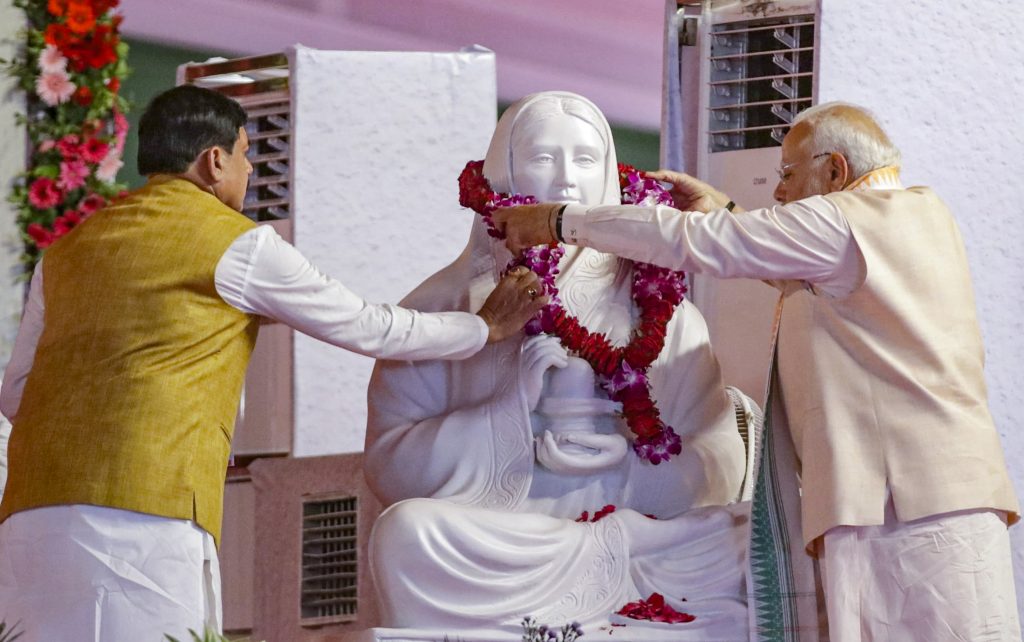
In this image posted by @CMMadhyaPradesh via X on May 31, Prime Minister Modi and Madhya Pradesh chief minister Mohan Yadav pay tribute to Ahilyabai Holkar on her 300th birth anniversary in Bhopal. Photo via PTI.
On March 16, 2024, at its annual Akhil Bharatiya Pratinidhi Sabha, the highest decision-making body of the RSS, general secretary Dattatreya Hosabale announced a massive, one-year calendar of events to commemorate Ahilyabai’s tricentenary. Her celebration was part of the organisation’s broader ‘Panch Parivartan’ (five-point transformation) agenda.
Since then, the BJP-RSS has left no stone unturned in commemorative programmes – a blitzkrieg of widely publicised events, statue installations and naming ceremonies in Ahilyabai’s name, with activities intensifying in the lead-up to the anniversary.
From May 21 to 31, the BJP launched a “Smriti Abhiyan” – a nationwide commemorative campaign supported by the Union and state governments, framed around themes of women’s empowerment, Hindu heritage and good governance. On May 22, the Union government announced the release of a special Rs 300 coin to mark her 300th birth anniversary.
State governments have been equally forceful. In an ambitiously planned tribute, Madhya Pradesh chief minister Mohan Yadav launched a nine-month-long celebration spanning cultural and educational events across the state. The Maharashtra government has allocated more than Rs 600 crore for the development of the Punyashlok Ahilyabai Holkar Smarak Sthal, a memorial site at Chaundi, the queen’s birthplace in Ahilyanagar (formerly Ahmednagar, renamed shortly before Maharashtra’s 2024 assembly elections).
Even states not directly connected with the queen’s legacy are involved. Uttar Pradesh has embraced the commemorations with particular zeal. On May 16, the state’s directorate of secondary education issued a circular instructing schools in every district to hold commemorative events, including essay competitions and runs for women’s empowerment.
The grassroots reality
But this grand political theatre is meeting resistance from the very community it aims to court. “For the RSS-BJP, Ahilyabai’s temple work is emphasised and mentioned in every commemoration. There’s a perception building that Ahilyabai is becoming a national figure only because of the BJP’s programmes,” says Pushkar Pal, an advocate at the civil court in Rae Bareilly.
“Many in the community feel drawn to the BJP for honouring our queen.” Yet, he notes, a significant section is also beginning to question the intent behind these commemorations. “They see through the symbolism. It’s a lollipop – a sweet promise without real political inclusion, without actual tickets or representation.”
With around 6% of the vote share in Uttar Pradesh, Pushkar claims, the Gadariyas may be smaller in number than the Yadavs, but their vote bank has the potential to swing outcomes. “The BJP has found the perfect icon – Ahilyabai as a Shiv bhakt, temple builder and a figure easily integrated into the Hindutva narrative. But that alone won’t be enough.”
According to Pushkar, among the younger generation, there is a growing push for bhagyadari – political participation. Symbolic respect, while meaningful to some, no longer satisfies many in a community increasingly aware of its political power. “If you ask me, whoever gives the Gadariyas 20 tickets will win their vote. That will matter more than anything else,” he adds.
The man instrumental in initiating the resonance of Ahilyabai as a community icon is 72-year-old J.P. Dhangar. In his room-and-a-half home in Shahganj, Agra, a portrait of Ahilyabai hangs on the wall, with a small idol placed beneath it. Books lie scattered, and newspaper clippings about the Gadariya community spill out from worn files.
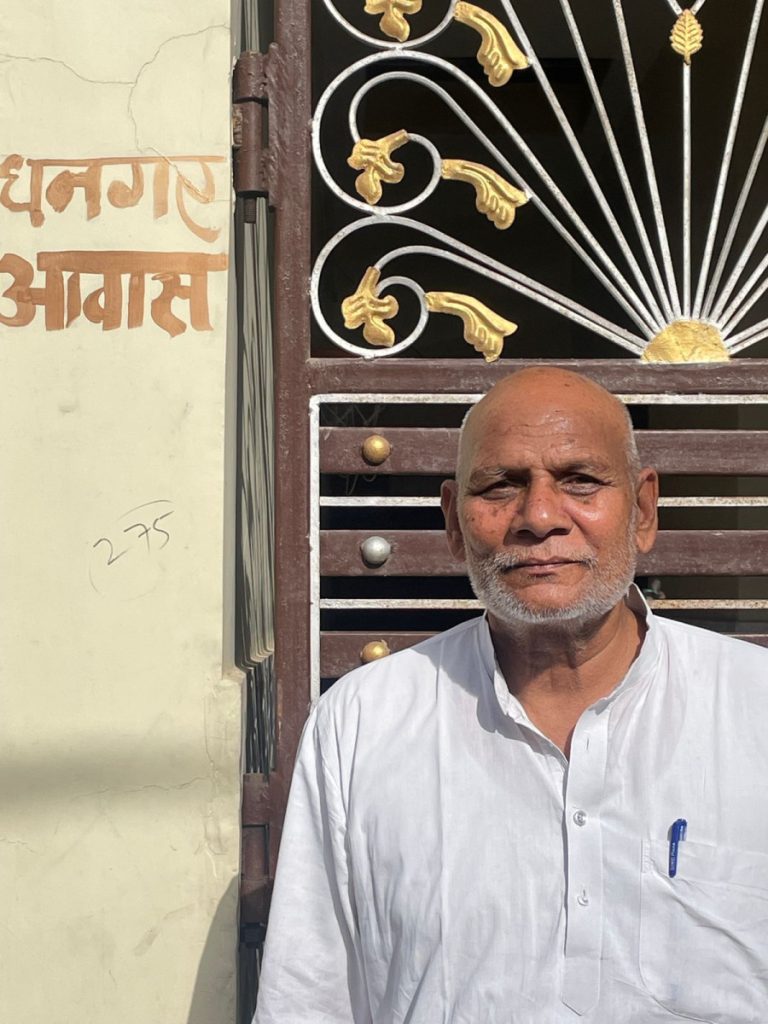
J.P. Dhangar at his home in Agra. Photo provided by author.
In 1994, he founded the Dhangar Samaj Sangharsh Samiti, which later became the Rashtriya Dhangar Mahasabha.
“We are a community of bhed–bakri, with little literacy, getting left behind in the modern world. I wanted the Gadariyas to come together and fight for their rights,” Dhangar had told me when I met him on June 1, 2023. It was the day his organisation and a few other Gadariya groups led a procession through parts of the city to mark Ahilyabai’s 298th birth anniversary.
Despite BJP leaders approaching him to join their party, Dhangar has remained resolute. “Unlike other caste leaders who are driven by a desire for power, I will never join a party that upholds the brahman vyavastha (Brahminical system).”
Now when I spoke to Dhangar on the eve of the 300th anniversary, he listed the events he would be part of in Hathras. “Unlike the BJP, we have always honoured our queen, not just stepped up celebrations before elections. In Maharashtra, where our numbers are large and politically important, they renamed Ahmednagar as Ahilyanagar only one month before elections.”
The turning point
The disillusionment with the BJP is voiced even by those within the party. On February 4, 2024, I attended the Vishal Pradeshik Ati Pichhda Varg Pratinidhi Sammelan (State-Level Convention of Extremely Backward Class Representatives) in Lucknow, organised by Satish Pal, a BJP member and former minister in the Mayawati government.
On the dais of the packed Visvesvaraya Hall, a garlanded portrait of Ahilyabai was placed with reverence. Every speaker began by offering flowers at her feet. The occasion was to honour the Bharat Ratna awarded to Karpoori Thakur, called the “Jan Nayak” of marginalised communities, and discuss the political future of shepherding communities.
“We are the vansaj of Ahilyabai; she is our guiding light, and I’m grateful the BJP is honouring her in different ways,” Pal told me. Yet, he didn’t hesitate to voice his central demand: “I may be in the BJP and would like to remain in it – but only if they give us political representation.”
That ticket never came. In the 2024 general elections, Pal was denied a BJP nomination. Instead, he became a vocal critic of BJP’s Kannauj candidate, Subrat Pathak, when a viral audio clip emerged in which Pathak could be heard hurling insults at Pal and mocking his political ambitions.
“That moment was a turning point,” said a local leader. “After hearing that audio, the majority of the Pal and Dhangar communities shifted their support to Akhilesh Yadav, contributing to his resounding victory from Kannauj. There was a ripple effect across strongholds of the Gadariya community. Just look at the vote margins – you can do the math.”
The Samajwadi Party has moved quickly to capitalise on this discontent. “The BJP doesn’t need to teach us the ideals of Ahilyabai Holkar,” said Laxmi Dhangar, national president of the women’s wing of the Akhil Bhartiya Dhangar Samaj Mahasangh and the Samajwadi Party’s district president from Aligarh. “We are her children. We’ve been honouring her in countless ways – without publicising every gesture. We’re holding booth-level celebrations for our queen.”
In January 2024, shortly before the national elections, Yadav appointed Shyam Lal Pal, a leader from the Gadariya community, as the party’s pradesh adhyaksh. It was widely seen as a strategic signal to the Gadariyas and other extremely backward communities.
The Samajwadi Party has also announced a series of events to mark Ahilyabai’s 300th birth anniversary and promised to construct a golden memorial along the Gomti riverfront.
“The Gadariya community is a crucial community in UP. The BJP is making a visible push, evoking Ahilyabai Holkar’s name more frequently, knowing it resonates with our community – but it won’t be enough,” Laxmi observed.
The BJP is also facing anger over its failure to meet the demand for issuing caste certificates. This demand is tied to the internal divisions within the Gadariya community, which comprises two sub-castes: the Dhangars – classified as a Scheduled Caste in Uttar Pradesh – and the Nikhar, who usually write ‘Pal’ and are listed as OBC.
On the ground, there is a growing demand for SC status for the entire community. On May 4, in a widely reported protest, members of the Rashtriya Dhangar Mahasabha, along with others from the community, marched to the residence of Agra BJP MP S.P. Baghel – a Gadariya himself – accusing him of failing to facilitate SC caste certificates for the community while personally benefiting from a reserved constituency.
Beyond symbolism
As Modi takes centre-stage at the grand celebration in Bhopal today, the RSS-BJP’s year-long campaign to appropriate Ahilyabai reveals both the sophistication and the limitations of their political strategy.
They have identified the perfect icon – a devout Hindu queen who built temples, embodied women’s empowerment and belonged to a backward caste community. Her legacy allows them to simultaneously appeal to Hindutva sentiments, OBC politics and gender inclusivity.
Yet the Gadariya community’s response in Uttar Pradesh suggests that symbolic politics, however carefully crafted, cannot substitute for substantive political inclusion. The very community the BJP seeks to win over through Ahilyabai’s legacy is demanding what she herself wielded – real power, not just reverence.
The queen’s 300th birth anniversary marks not only a celebration of her legacy, but also how India’s most marginalised communities are renegotiating their relationship with political power.
As Dhangar observed, “We have always honoured our queen.” The question now is whether political parties will honour her descendants with more than just ceremonial recognition.
Also Read: Operation Sindoor Reveals Future Warfare Tactics: CDS Anil Chauhan Highlights 5 Key Takeaways






